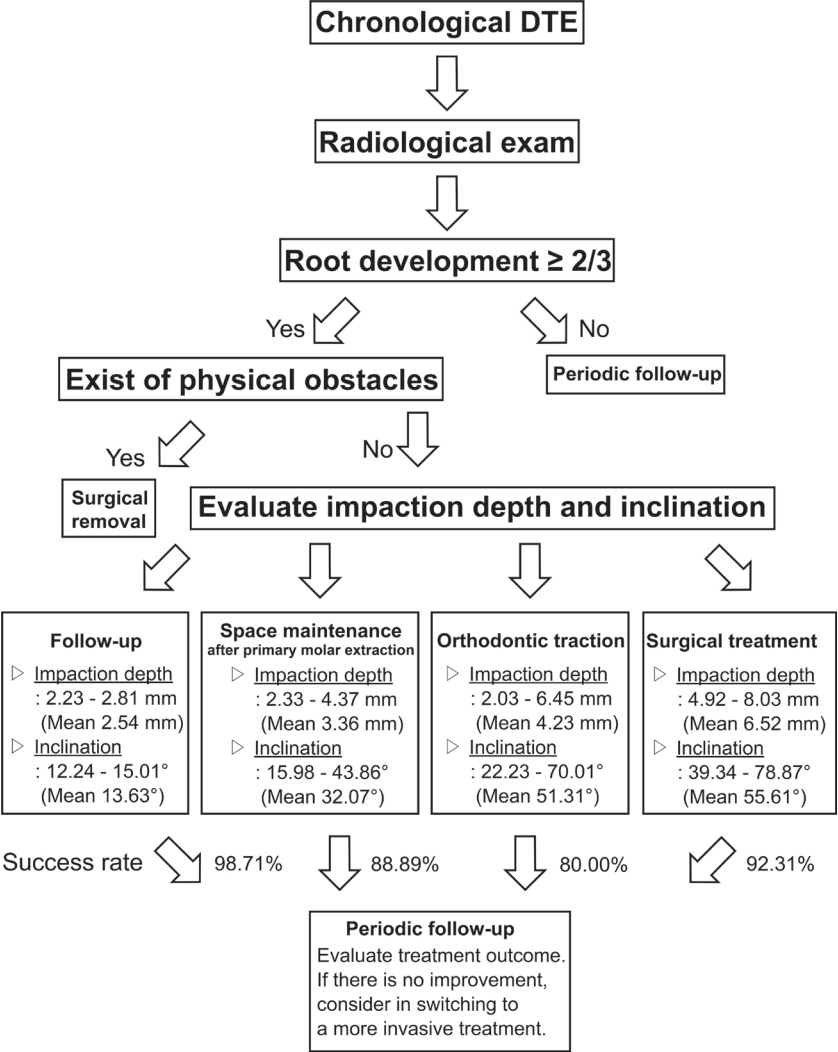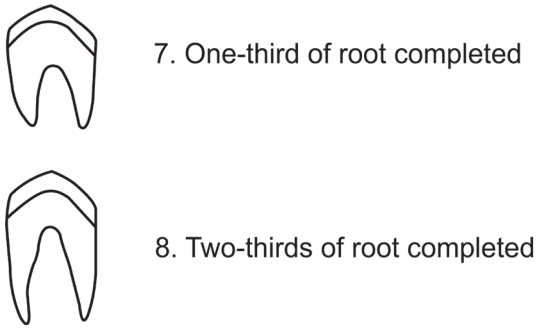1. Schour L, Massler M : The development of the human dentition. J Am Dent Assoc, 28:1153-1160, 1941.
2. Moorrees CF, Fanning EA, Hunt Jr EE : Age variation of formation stages for ten permanent teeth.
J Dent Res, 42:1490-1502, 1963.



3. Nolla CM : The development of the human dentition. ASDC J Dent Child, 27:254-266, 1960.
4. Johnsen DC : Prevalence of delayed emergence of permanent teeth as a result of local factors.
J Am Dent Assoc, 94:100-106, 1977.


5. Suri L, Gagari E, Vastardis H : Delayed tooth eruption: pathogenesis, diagnosis, and treatment.
Am J Orthod Dentofacial Orthop, 126:432-445, 2004.

6. Burch J, Ngan P, Hackman A : Diagnosis and treatment planning for unerupted premolars.
Pediatr Dent, 16:89-95, 1994.

7. Peedikayil FC : Delayed tooth eruption. e-Journal of Dentistry, 1:81-86, 2011.
8. Krarup S, Darvann TA, Larsen P, Marsh JL, Kreiborg S : Three-dimensional analysis of mandibular growth and tooth eruption.
J Anat, 207:669-682, 2005.



9. Suh HW, Song JS, Shin TJ, Hyun HK, Kim YJ, Kim JW, Lee SH, Jang KT : Characteristics and treatment methods of eruption disturbance.
J Korean Acad Pediatr Dent, 45:464-473, 2018.

10. Noda T, Takagi M, Hayashi-Sakai S, Taguchi Y : Eruption disturbances in Japanese children and adolescents.
Pediatr Dent J, 16:50-56, 2006.

11. Oikarinen VJ, Julku M : Impacted premolars. An analysis of 10,000 orthopantomograms.
Proc Finn Dent Soc, 70:95-98, 1974.

12. Aktan AM, Kara İ, Şener İ, Bereket C, Çelik S, Kırtay M, Çiftçi ME, Arıcı N : An evaluation of factors associated with persistent primary teeth.
Eur J Orthod, 34:208-212, 2012.


13. Sletten DW, Smith BM, Southard KA, Casko JS, Southard TE : Retained deciduous mandibular molars in adults: a radiographic study of long-term changes.
Am J Orthod Dentofacial Orthop, 124:625-630, 2003.


14. Arid J, Vitiello MC, Silva RAB, da Silva LAB, de Queiroz AM, Küchler EC, Nelson-Filho P : Nutritional status is associated with permanent tooth eruption chronology.
Braz J Oral Sci, 16:1-7, 2017.


15. Alshukairi H : Delayed tooth eruption and its pathogenesis in paediatric patient: a review.
J Dent Health Oral Disord Ther, 10:209-212, 2019.

16. Xavier TA, Madalena IR, da Silva RAB, da Silva LAB, Silva MJB, De Rossi A, Küchler EC, Fukada SY : Vitamin D deficiency is a risk factor for delayed tooth eruption associated with persistent primary tooth.
Acta Odontol Scand, 79:600-605, 2021.


17. Ismail MQ, Lauridsen E, Andreasen JO, Hermann NV : Ectopic eruption of the second premolar: an analysis of four different treatment approaches.
Eur Arch Paediatr Dent, 21:119-127, 2020.



18. Henklein SD, Küchler EC, Proff P, Lepri CP, Baratto-Filho F, Mattos NHR, Hueb de Menezes FC, Kirschneck C, Madalena IR, Hueb de Menezes-Oliveira MA : Prevalence and local causes for retention of primary teeth and the associated delayed permanent tooth eruption.
J Orofac Orthop, 2023 Jul 3. doi: 10.1007/s00056-023-00479-x. Online ahead of print


19. Oh TJ, Nam OH, Kim MS, Lee HS, Kim KC, Choi SC : Eruption stage of permanent teeth using diagnostic model analysis in Kyung Hee Dental Hospital.
J Korean Acad Pediatr Dent, 46:10-20, 2019.

20. Dean JA : McDonald and Avery’s dentistry for the child and adolescent, 11th ed. E-book. Elsevier Health Sciences, St. Louis, 2021
21. Kaban LB, Needleman HL, Hertzberg J : Idiopathic failure of eruption of permanent molar teeth.
Oral Surg Oral Med Oral Pathol, 42:155-163, 1976.


22. Kochhar R, Richardson A : The chronology and sequence of eruption of human permanent teeth in Northern Ireland.
Int J Paediatr Dent, 8:243-252, 1998.


23. Goho C : Delayed eruption due to overlying fibrous connective tissue.
ASDC J Dent Child, 54:359-360, 1987.

24. Di Biase DD : Mucous membrane and delayed eruption.
Dent Pract Dent Rec, 21:241-250, 1971.

25. Park MK, Shin MK, Kim SO, Lee HS, Lee JH, Jung HS, Song JS : Prevalence of delayed tooth development and its relation to tooth agenesis in Korean children.
Arch Oral Biol, 73:243-247, 2017.


26. Alexander-Abt J : Apparent hypodontia: a case of misdiagnosis.
Am J Orthod Dentofacial Orthop, 116:321-323, 1999.


27. Yaghoobi M : Late development of lower second premolar with a significant delay in comparison with normal development in a 12 years old girl.
J North Khorasan Univ Med Sci, 6:677-681, 2014.


28. Flaitz CM, Hicks J : Delayed tooth eruption associated with an ameloblastic fibro-odontoma.
Pediatr Dent, 23:253-254, 2001.

29. Avelar RL, Primo BT, Pinheiro-Nogueira CB, Studart-Soares EC, de Oliveira RB, de Medeiros JR, Hernandez PAG : Worldwide incidence of odontogenic tumors.
J Craniofac Surg, 22:2118-2123, 2011.


30. Isola G, Cicciù M, Fiorillo L, Matarese G : Association between odontoma and impacted teeth.
J Craniofac Surg, 28:755-758, 2017.


31. Chirapathomsakul D, Sastravaha P, Jansisyanont P : A review of odontogenic keratocysts and the behavior of recurrences.
Oral Surg Oral Med Oral Pathol Oral Radiol Endod, 101:5-9, 2006.


32. McDonald RE, Avery DR : Dentistry for the child and adolescent, 2nd ed. Mosby, St. Louis, 1974
33. Houston WJB, Tulley WJ, Campbell AC, Poswillo DE, Foster ME : A textbook of orthodontics, 2nd ed. Wright Publishing; Albuquerque, 1992
34. DiBiase DD : The effects of variations in tooth morphology and position on eruption. Dent Prac Dent Rec, 22:95-108, 1971.
35. Kerr WJ : The effect of the premature loss of deciduous canines and molars on the eruption of their successors.
Eur J Orthod, 2:123-128, 1980.


36. Messer LB, Cline JT : Ankylosed primary molars: results and treatment recommendations from an eightyear longitudinal study.
Pediatr Dent, 2:37-47, 1980.

37. Tieu LD, Walker SL, Major MP, Flores-Mir C : Management of ankylosed primary molars with premolar successors: a systematic review.
J Am Dent Assoc, 144:602-611, 2013.

38. Kurol J, Thilander B : Infraocclusion of primary molars and the effect on occlusal development, a longitudinal study.
Eur J Orthod, 6:277-293, 1984.


39. Pahkala R, Pahkala A, Laine T : Eruption pattern of permanent teeth in a rural community in northeastern Finland.
Acta Odontol Scand, 49:341-349, 1991.


40. Zuccati G, Ghobadlu J, Nieri M, Clauser C : Factors associated with the duration of forced eruption of impacted maxillary canines: a retrospective study.
Am J Orthod Dentofacial Orthop, 130:349-356, 2006.


41. Spyropoulos ND : Orientation and eruptive patterns of the mandibular second premolar.
Oral Surg Oral Med Oral Pathol, 69:642-646, 1990.


42. Wasserstein A, Brezniak N, Shalish M, Heller M, Rakocz M : Angular changes and their rates in concurrence to developmental stages of the mandibular second premolar.
Angle Orthod, 74:332-336, 2004.

43. Ferreira DCA, Fumes AC, Consolaro A, Nelson-Filho P, de Queiroz AM, De Rossi A : Gubernacular cord and canal - does these anatomical structures play a role in dental eruption?
RSBO, 10:167-171, 2013.


44. Jacobs SG : Radiographic localization of unerupted teeth: further findings about the vertical tube shift method and other localization techniques.
Am J Orthod Dentofacial Orthop, 118:439-447, 2000.

















 PDF Links
PDF Links PubReader
PubReader ePub Link
ePub Link Full text via DOI
Full text via DOI Download Citation
Download Citation Print
Print



